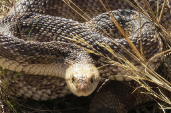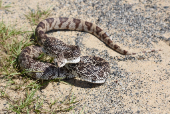Florida Pine Snake (Pituophis melanoleucus mugitus)
Description: The Florida pine snake is one of the largest snakes in eastern North America. This species can reach a length of up to 84 inches. It has a brown back with dark blotches, white belly, ridged scales, small head, and pointed snout. Adult Florida pinesnakes have a variable pattern of dark brown or rust-colored blotches on a light cream to tan background color. These markings are more distinct and vividly colored toward the tail and more indistinct or faded in appearance toward the head, which often has variable darker markings. Young Florida pinesnakes look much like the adults, but the dark markings are more defined.
Habitat: Florida pinesnakes favor dry, upland areas with well-drained, sandy soils. Their preferred natural habitats include upland pine forests and sandhills, but they are also found in scrubby flatwoods, oak scrub, dry oak forests, old fields and agricultural borders. Unfortunately, the development and fragmentation of these native habitats for residential and commercial use have caused Florida pinesnakes to become much less common in the landscape.
Range: Florida pinesnakes are found in the extreme Southeastern Coastal Plain of the United States, in the area from the southern tip of South Carolina west through southern Georgia and extreme southeastern Alabama, and south through most of peninsular Florida.
Found in these States:
AL |
FL |
GA |
SC
Diet: The diet of the Florida pine snake primarily consists of moles, rabbits, mice, rats, squirrels, lizards, and other snakes and their eggs.
Reproduction: Nesting occurs from June to August, with the eggs hatching in September and October. Nests are constructed in side burrows located off of the species main burrow. The female will construct the burrow alone, usually in an area that receives a lot of sunlight. The clutch size for the Florida pine snake is 4-12 eggs. The incubation time for eggs ranges from 67-72 days.
Status: Listed as Least Concern in view of the fairly large range and number of subpopulations/locations and because it is unlikely to be declining fast enough to qualify for listing in a more threatened category.
»» Kingdom: Animalia - Animals
»» Phylum: Chordata - Chordates
»» Subphylum: Vertebrata - Vertebrates
»» Class: Reptilia - Reptiles
»» Order: Squamata - Scaled Reptiles
»» Suborder: Serpentes
»» Superfamily: Colubroidea
»» Family: Colubridae - Colubrids
»» Genus: Pituophis
»» Species: Pituophis melanoleucus - Pine Snakes
»» Subspecies: Pituophis melanoleucus mugitus - Florida Pine Snake
This article uses material from the Wikipedia article "Pituophis melanoleucus", which is released under the Creative Commons Attribution-Share-Alike License 3.0. Content may have been omitted from the original, but no content has been changed or extended.
|








